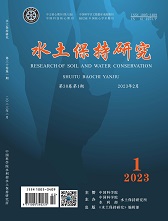[1]ZHANG Bin,XIA Qiuyue.Topographic Gradient Effect and Vulnerability Analysis of Carbon Storage in Wuhan Urban Circle[J].Research of Soil and Water Conservation,2023,30(05):443-452.[doi:10.13869/j.cnki.rswc.2023.05.002.]
Copy
Topographic Gradient Effect and Vulnerability Analysis of Carbon Storage in Wuhan Urban Circle
Research of Soil and Water Conservation[ISSN 1005-3409/CN 61-1272/P] Volume:
30
Number of periods:
2023 05
Page number:
443-452
Column:
Public date:
2023-08-10
- Title:
- Topographic Gradient Effect and Vulnerability Analysis of Carbon Storage in Wuhan Urban Circle
- CLC:
- X171.1
- DOI:
- 10.13869/j.cnki.rswc.2023.05.002.
- Abstract:
- [Objective] Accurately assessing the spatial and temporal differentiation of regional carbon storage, and analyzing its topographic gradient effect and vulnerability to land use, are of great significance for the implementation of the regional ‘two carbon' goal. [Methods] Wuhan urban circle was taken as an example. The InVEST model was used to evaluate the spatial and temporal differentiation characteristics of regional carbon storage with the help of GIS platform, and based on DEM data, the terrain index was used to explore the topographic gradient effect of carbon storage, and the potential impact index was used to reveal the vulnerability of carbon storage. [Results](1)From 2005 to 2020, the total carbon storage in Wuhan urban circle first decreased and then increased, showing a trend of low in the middle and west and high in the north and south in terms of spatial distribution, with large differences between cities.(2)The topographic position of Wuhan urban circle is generally low in the central and western regions and high in the north and south, with the largest proportion of level 1. From the spatial autocorrelation analysis, it can be seen that there is a significant positive spatial correlation between regional topographical position and carbon density.(3)The conversion of cultivated land to construction land is the main reason for the loss of regional carbon storage, resulting in a carbon loss of up to 7.068 Tg, while the conversion of cultivated land to forest land is the main reason for the increase of regional carbon storage, expanding the regional carbon pool by 7.62 Tg. As far as the vulnerability assessment of carbon storage was concerned, from the perspective of the urban circle as a whole, the PI indices from 2005 to 2020 were all negative, indicating that regional land use could have a negative potential impact on carbon storage. [Conclusion] The carbon storage in Wuhan urban circle has generally decreased and there are significant differences among internal cities. The topographic position is significantly positively correlated with carbon density, and the vulnerability of carbon storage is high due to land use change.
- References:
-
[1] Guo X, Fang C. Integrated land use change related carbon source/sink examination in Jiangsu Province[J]. Land, 2021,10(12):1310-1328.
[2] Gu S, Li S, Santos I R. Anthropogenic land use substantially increases riverine CO2 emissions[J]. Journal of Environmental Sciences, 2022,118(8):158-170.
[3] Sha Z, Bai Y, Li R, et al. The global carbon sink potential of terrestrial vegetation can be increased substantially by optimal land management[J]. Communications Earth & Environment, 2022,3(1):1-10.
[4] Gao R, Chuai X, Ge J, et al. An integrated tele-coupling analysis for requisition-compensation balance and its influence on carbon storage in China[J]. Land Use Policy, 2022,116(5):106-117.
[5] 张平平,李艳红,殷浩然,等.中国南北过渡带生态系统碳储量时空变化及动态模拟[J].自然资源学报,2022,37(5):1183-1197.
[6] 李姣,汪杰,李朗,等.洞庭湖生态经济区土地利用变化对碳储量的影响[J].生态学杂志,2022,41(6):1156-1165.
[7] 张凯琪,陈建军,侯建坤,等.耦合InVEST与GeoSOS-FLUS模型的桂林市碳储量可持续发展研究[J].中国环境科学,2022,42(6):2799-2809.
[8] 王天福,龚直文,邓元杰.基于土地利用变化的陕西省植被碳汇提质增效优先区识别[J].自然资源学报,2022,37(5):1214-1232.
[9] 张立,金晶泽,姜侠,等.1986—2019年黑龙江省松嫩平原表层土壤有机碳变化及固碳潜力估算[J].现代地质,2021,35(4):914-922.
[10] 陈美景,王庆日,白中科,等.碳中和愿景下“三生空间”转型及其碳储量效应:以贵州省为例[J].中国土地科学,2021,35(11):101-111.
[11] Rijal S, Rimal B, Acharya R P, et al. Land use/land cover change and ecosystem services in the Bagmati River Basin, Nepal[J]. Environmental Monitoring and Assessment, 2021,193(10):1-17.
[12] 王晓萌,潘佩佩,王晓旭,等.基于土地利用的河北省生态系统服务权衡/协同关系研究[J].地理与地理信息科学,2021,37(1):80-88.
[13] 刘国栋,戴慧敏,杨泽,等.三江平原土壤碳库时空变化和影响因素研究[J].现代地质,2021,35(2):443-454.
[14] Li Z, Cheng X, Han H. Future impacts of land use change on ecosystem services under different scenarios in the ecological conservation area, Beijing, China[J]. Forests, 2020,11(5):58-70.
[15] 刘洋,张军,周冬梅,等.基于InVEST模型的疏勒河流域碳储量时空变化研究[J].生态学报,2021,41(10):4052-4065.
[16] 李瑾璞,于秀波,夏少霞,等.白洋淀湿地区土壤有机碳密度及储量的空间分布特征[J].生态学报,2020,40(24):8928-8935.
[17] 隋玉正,孙大鹏,李淑娟,等.碳储存变化背景下东营市海岸带生态系统保护修复[J].生态学报,2021,41(20):8112-8123.
[18] Ahmadi Mirghaed F, Souri B. Effect of landscape fragmentation on soil quality and ecosystem services in land use and landform types[J]. Environmental Earth Sciences, 2022,81(12):1-13.
[19] 李妙宇,上官周平,邓蕾.黄土高原地区生态系统碳储量空间分布及其影响因素[J].生态学报,2021,41(17):6786-6799.
[20] 徐彩仙,巩杰,李焱,等.基于地形梯度的甘肃白龙江流域典型生态系统服务分布特征[J].生态学报,2020,40(13):4291-4301.
[21] Xu X, Wang L, Sun M, et al. Climate change vulnerability assessment for smallholder farmers in China:An extended framework[J]. Journal of Environmental Management, 2020,276(12):111-123.
[22] Sekhri S, Kumar P, Fürst C, et al. Mountain specific multi-hazard risk management framework(MSMRMF):Assessment and mitigation of multi-hazard and climate change risk in the Indian Himalayan Region[J]. Ecological Indicators, 2020,118(12):106700-106713.
[23] Liu L, Liang Y, Hashimoto S. Integrated assessment of land-use/coverage changes and their impacts on ecosystem services in Gansu Province, northwest China:Implications for sustainable development goals[J]. Sustainability Science, 2020,15(1):297-314.
[24] 闫啸,李录堂,李晗.宅基地退出降低了农户的贫困脆弱性吗:来自安徽金寨的证据[J].中国土地科学,2022,36(4):38-48.
[25] 牛志君,周亚鹏,王树涛,等.县域土地利用变化对碳储量的影响与评价:以黑龙港流域巨鹿县为例[J].水土保持研究,2018,25(3):292-297,304.
[26] 向书江,张骞,王丹,等.近20年重庆市主城区碳储量对土地利用/覆被变化的响应及脆弱性分析[J].自然资源学报,2022,37(5):1198-1213.
[27] 李若玮,叶冲冲,王毅,等.基于InVEST模型的青藏高原碳储量估算及其驱动力分析[J].草地学报,2021,29(S1):43-51.
[28] 张斌,李璐,夏秋月,等.“三线”约束下土地利用变化及其对碳储量的影响:以武汉城市圈为例[J].生态学报,2022,42(6):2265-2280.
[29] 张玉,张道军.地形位指数模型改进及其在植被覆盖评价中的应用[J].地理学报,2022,77(11):2757-2772.
[30] 危小建,赵莉,程朋根,等.中国土地利用与生态服务价值空间动态研究:以地级及以上城市为例[J].水土保持研究,2022,29(4):370-376.
[31] Li L, Tang H, Lei J, et al. Spatial autocorrelation in land use type and ecosystem service value in Hainan Tropical Rain Forest National Park[J]. Ecological Indicators, 2022,137(4):108-120.
[32] 陈万旭,曾杰.中国土地利用程度与生态系统服务强度脱钩分析[J].自然资源学报,2021,36(11):2853-2864.
[33] Schröter D, Cramer W, Leemans R, et al. Ecosystem service supply and vulnerability to global change in Europe[J]. Science, 2005,310(5752):1333-1337.
[34] Metzger M J, Rounsevell M D A, Acosta-Michlik L, et al. The vulnerability of ecosystem services to land use change[J]. Agriculture, Ecosystems & Environment, 2006,114(1):69-85.
- Similar References:
Memo
-
Last Update:
2023-08-10
